window FIAT SCUDO 2010 Owner handbook (in English)
[x] Cancel search | Manufacturer: FIAT, Model Year: 2010, Model line: SCUDO, Model: FIAT SCUDO 2010Pages: 210, PDF Size: 3.32 MB
Page 76 of 210
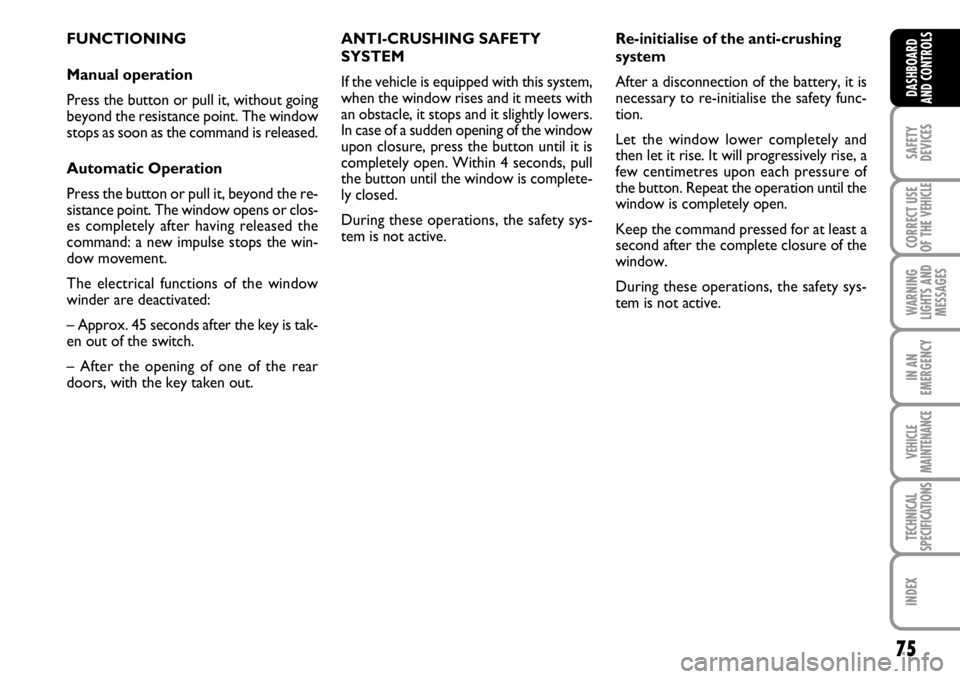
75
SAFETY
DEVICES
CORRECT USE
OF THE
VEHICLE
WARNING
LIGHTS AND
MESSAGES
IN AN
EMERGENCY
VEHICLE
MAINTENANCE
TECHNICAL
SPECIFICATIONS
INDEX
DASHBOARD
AND CONTROLS
FUNCTIONING
Manual operation
Press the button or pull it, without going
beyond the resistance point. The window
stops as soon as the command is released.
Automatic Operation
Press the button or pull it, beyond the re-
sistance point. The window opens or clos-
es completely after having released the
command: a new impulse stops the win-
dow movement.
The electrical functions of the window
winder are deactivated:
– Approx. 45 seconds after the key is tak-
en out of the switch.
– After the opening of one of the rear
doors, with the key taken out.ANTI-CRUSHING SAFETY
SYSTEM
If the vehicle is equipped with this system,
when the window rises and it meets with
an obstacle, it stops and it slightly lowers.
In case of a sudden opening of the window
upon closure, press the button until it is
completely open. Within 4 seconds, pull
the button until the window is complete-
ly closed.
During these operations, the safety sys-
tem is not active.Re-initialise of the anti-crushing
system
After a disconnection of the battery, it is
necessary to re-initialise the safety func-
tion.
Let the window lower completely and
then let it rise. It will progressively rise, a
few centimetres upon each pressure of
the button. Repeat the operation until the
window is completely open.
Keep the command pressed for at least a
second after the complete closure of the
window.
During these operations, the safety sys-
tem is not active.
Page 110 of 210
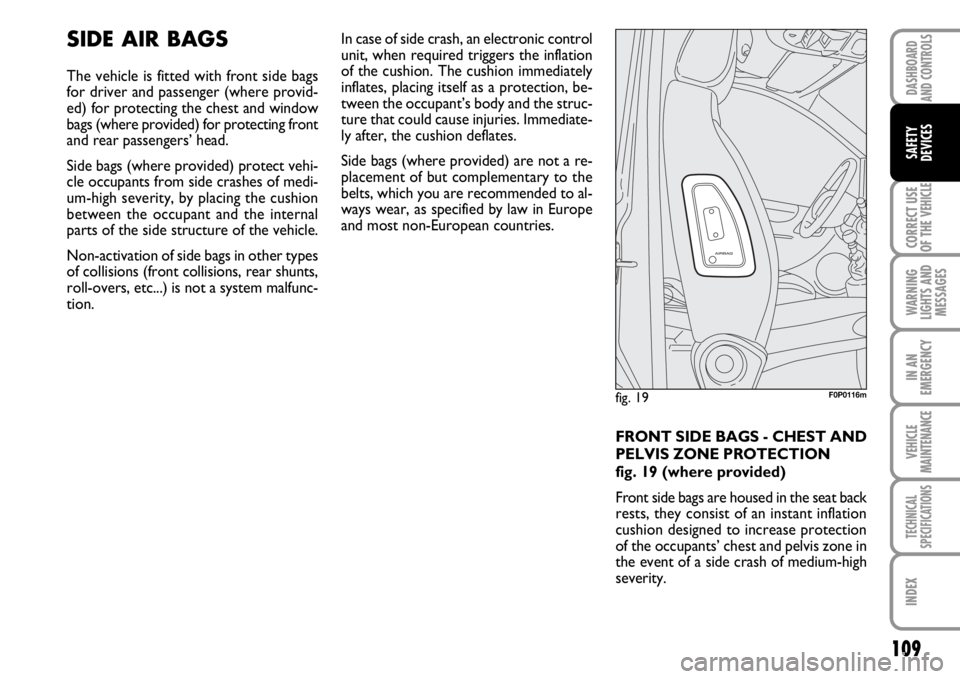
109
CORRECT USE
OF THE
VEHICLE
WARNING
LIGHTS AND
MESSAGES
IN AN
EMERGENCY
VEHICLE
MAINTENANCE
TECHNICAL
SPECIFICATIONS
INDEX
DASHBOARD
AND CONTROLS
SAFETY
DEVICES
SIDE AIR BAGS
The vehicle is fitted with front side bags
for driver and passenger (where provid-
ed) for protecting the chest and window
bags (where provided) for protecting front
and rear passengers’ head.
Side bags (where provided) protect vehi-
cle occupants from side crashes of medi-
um-high severity, by placing the cushion
between the occupant and the internal
parts of the side structure of the vehicle.
Non-activation of side bags in other types
of collisions (front collisions, rear shunts,
roll-overs, etc...) is not a system malfunc-
tion.In case of side crash, an electronic control
unit, when required triggers the inflation
of the cushion. The cushion immediately
inflates, placing itself as a protection, be-
tween the occupant’s body and the struc-
ture that could cause injuries. Immediate-
ly after, the cushion deflates.
Side bags (where provided) are not a re-
placement of but complementary to the
belts, which you are recommended to al-
ways wear, as specified by law in Europe
and most non-European countries.
fig. 19F0P0116m
FRONT SIDE BAGS - CHEST AND
PELVIS ZONE PROTECTION
fig. 19 (where provided)
Front side bags are housed in the seat back
rests, they consist of an instant inflation
cushion designed to increase protection
of the occupants’ chest and pelvis zone in
the event of a side crash of medium-high
severity.
Page 111 of 210
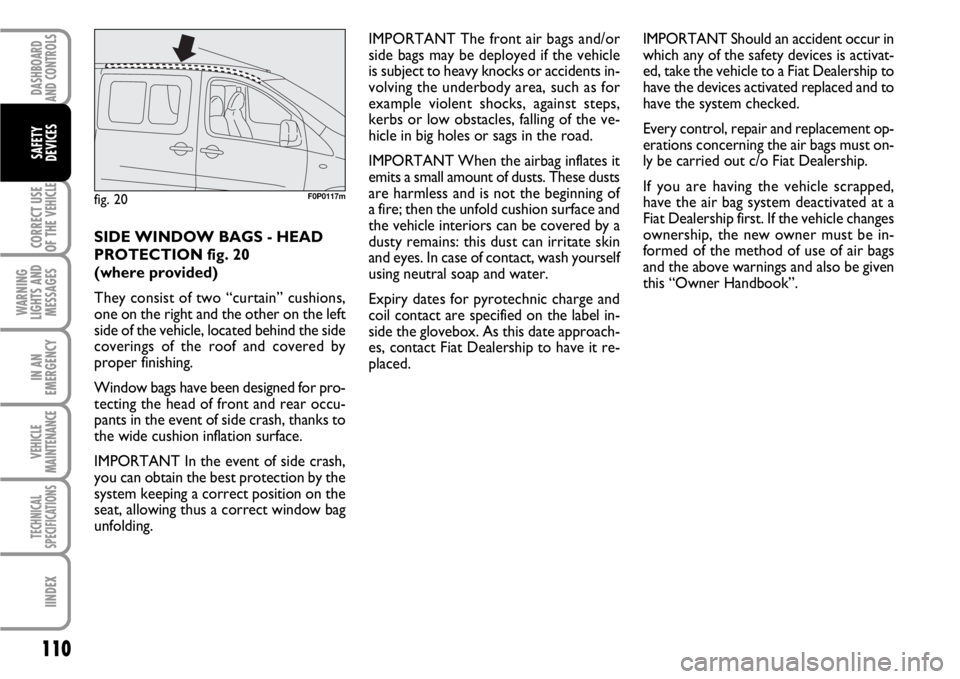
110
CORRECT USE
OF THE
VEHICLE
WARNING
LIGHTS AND
MESSAGES
IN AN
EMERGENCY
VEHICLE
MAINTENANCE
TECHNICAL
SPECIFICATIONS
IINDEX
DASHBOARD
AND CONTROLS
SAFETY
DEVICES
SIDE WINDOW BAGS - HEAD
PROTECTION fig. 20
(where provided)
They consist of two “curtain” cushions,
one on the right and the other on the left
side of the vehicle, located behind the side
coverings of the roof and covered by
proper finishing.
Window bags have been designed for pro-
tecting the head of front and rear occu-
pants in the event of side crash, thanks to
the wide cushion inflation surface.
IMPORTANT In the event of side crash,
you can obtain the best protection by the
system keeping a correct position on the
seat, allowing thus a correct window bag
unfolding.IMPORTANT The front air bags and/or
side bags may be deployed if the vehicle
is subject to heavy knocks or accidents in-
volving the underbody area, such as for
example violent shocks, against steps,
kerbs or low obstacles, falling of the ve-
hicle in big holes or sags in the road.
IMPORTANT When the airbag inflates it
emits a small amount of dusts. These dusts
are harmless and is not the beginning of
a fire; then the unfold cushion surface and
the vehicle interiors can be covered by a
dusty remains: this dust can irritate skin
and eyes. In case of contact, wash yourself
using neutral soap and water.
Expiry dates for pyrotechnic charge and
coil contact are specified on the label in-
side the glovebox. As this date approach-
es, contact Fiat Dealership to have it re-
placed.
fig. 20F0P0117m
IMPORTANT Should an accident occur in
which any of the safety devices is activat-
ed, take the vehicle to a Fiat Dealership to
have the devices activated replaced and to
have the system checked.
Every control, repair and replacement op-
erations concerning the air bags must on-
ly be carried out c/o Fiat Dealership.
If you are having the vehicle scrapped,
have the air bag system deactivated at a
Fiat Dealership first. If the vehicle changes
ownership, the new owner must be in-
formed of the method of use of air bags
and the above warnings and also be given
this “Owner Handbook”.
Page 112 of 210
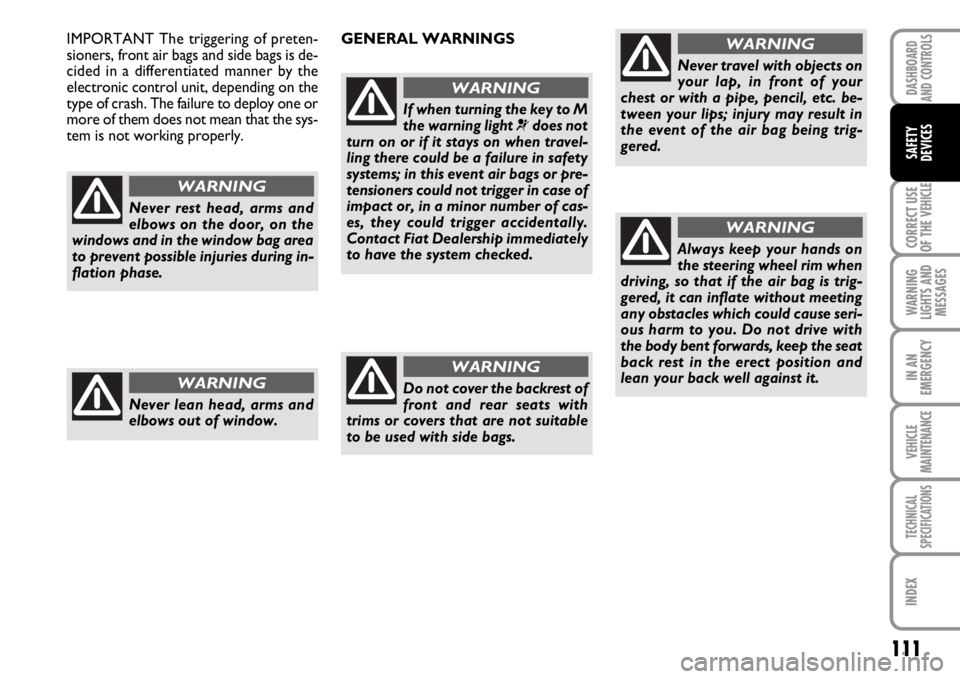
111
CORRECT USE
OF THE
VEHICLE
WARNING
LIGHTS AND
MESSAGES
IN AN
EMERGENCY
VEHICLE
MAINTENANCE
TECHNICAL
SPECIFICATIONS
INDEX
DASHBOARD
AND CONTROLS
SAFETY
DEVICES
Never rest head, arms and
elbows on the door, on the
windows and in the window bag area
to prevent possible injuries during in-
flation phase.
WARNING
Never lean head, arms and
elbows out of window.
WARNING
GENERAL WARNINGS
If when turning the key to M
the warning light ¬does not
turn on or if it stays on when travel-
ling there could be a failure in safety
systems; in this event air bags or pre-
tensioners could not trigger in case of
impact or, in a minor number of cas-
es, they could trigger accidentally.
Contact Fiat Dealership immediately
to have the system checked.
WARNING
Do not cover the backrest of
front and rear seats with
trims or covers that are not suitable
to be used with side bags.
WARNING
Never travel with objects on
your lap, in front of your
chest or with a pipe, pencil, etc. be-
tween your lips; injury may result in
the event of the air bag being trig-
gered.
WARNINGIMPORTANT The triggering of preten-
sioners, front air bags and side bags is de-
cided in a differentiated manner by the
electronic control unit, depending on the
type of crash. The failure to deploy one or
more of them does not mean that the sys-
tem is not working properly.
Always keep your hands on
the steering wheel rim when
driving, so that if the air bag is trig-
gered, it can inflate without meeting
any obstacles which could cause seri-
ous harm to you. Do not drive with
the body bent forwards, keep the seat
back rest in the erect position and
lean your back well against it.
WARNING
Page 119 of 210
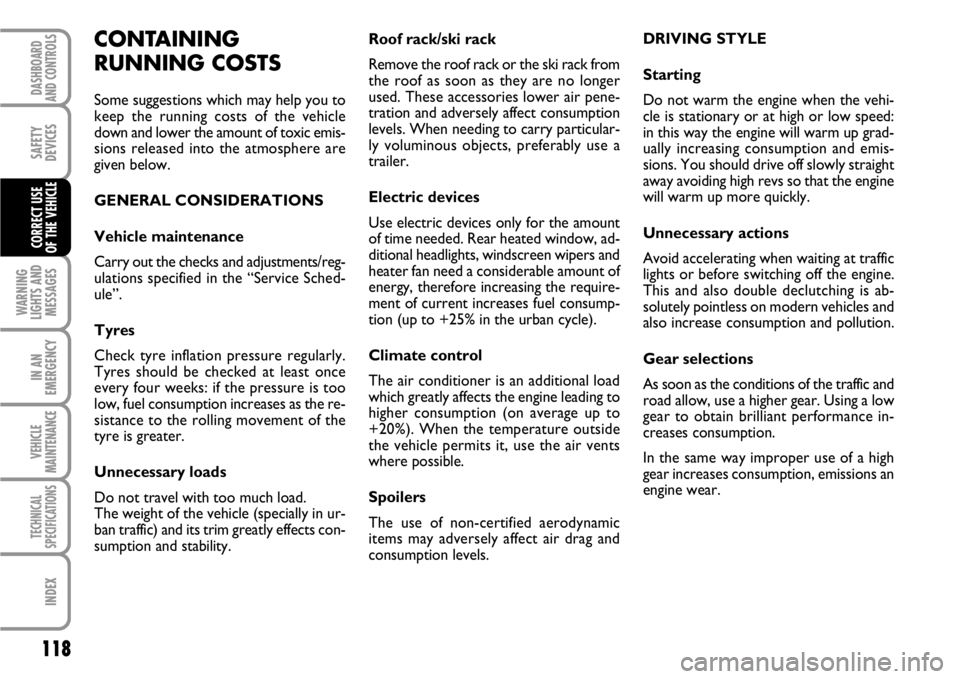
118
WARNING
LIGHTS AND
MESSAGES
IN AN
EMERGENCY
VEHICLE
MAINTENANCE
TECHNICAL
SPECIFICATIONS
INDEX
DASHBOARD
AND CONTROLS
SAFETY
DEVICES
CORRECT USE
OF THE VEHICLE
Roof rack/ski rack
Remove the roof rack or the ski rack from
the roof as soon as they are no longer
used. These accessories lower air pene-
tration and adversely affect consumption
levels. When needing to carry particular-
ly voluminous objects, preferably use a
trailer.
Electric devices
Use electric devices only for the amount
of time needed. Rear heated window, ad-
ditional headlights, windscreen wipers and
heater fan need a considerable amount of
energy, therefore increasing the require-
ment of current increases fuel consump-
tion (up to +25% in the urban cycle).
Climate control
The air conditioner is an additional load
which greatly affects the engine leading to
higher consumption (on average up to
+20%). When the temperature outside
the vehicle permits it, use the air vents
where possible.
Spoilers
The use of non-certified aerodynamic
items may adversely affect air drag and
consumption levels.DRIVING STYLE
Starting
Do not warm the engine when the vehi-
cle is stationary or at high or low speed:
in this way the engine will warm up grad-
ually increasing consumption and emis-
sions. You should drive off slowly straight
away avoiding high revs so that the engine
will warm up more quickly.
Unnecessary actions
Avoid accelerating when waiting at traffic
lights or before switching off the engine.
This and also double declutching is ab-
solutely pointless on modern vehicles and
also increase consumption and pollution.
Gear selections
As soon as the conditions of the traffic and
road allow, use a higher gear. Using a low
gear to obtain brilliant performance in-
creases consumption.
In the same way improper use of a high
gear increases consumption, emissions an
engine wear.CONTAINING
RUNNING COSTS
Some suggestions which may help you to
keep the running costs of the vehicle
down and lower the amount of toxic emis-
sions released into the atmosphere are
given below.
GENERAL CONSIDERATIONS
Vehicle maintenance
Carry out the checks and adjustments/reg-
ulations specified in the “Service Sched-
ule”.
Tyres
Check tyre inflation pressure regularly.
Tyres should be checked at least once
every four weeks: if the pressure is too
low, fuel consumption increases as the re-
sistance to the rolling movement of the
tyre is greater.
Unnecessary loads
Do not travel with too much load.
The weight of the vehicle (specially in ur-
ban traffic) and its trim greatly effects con-
sumption and stability.
Page 123 of 210
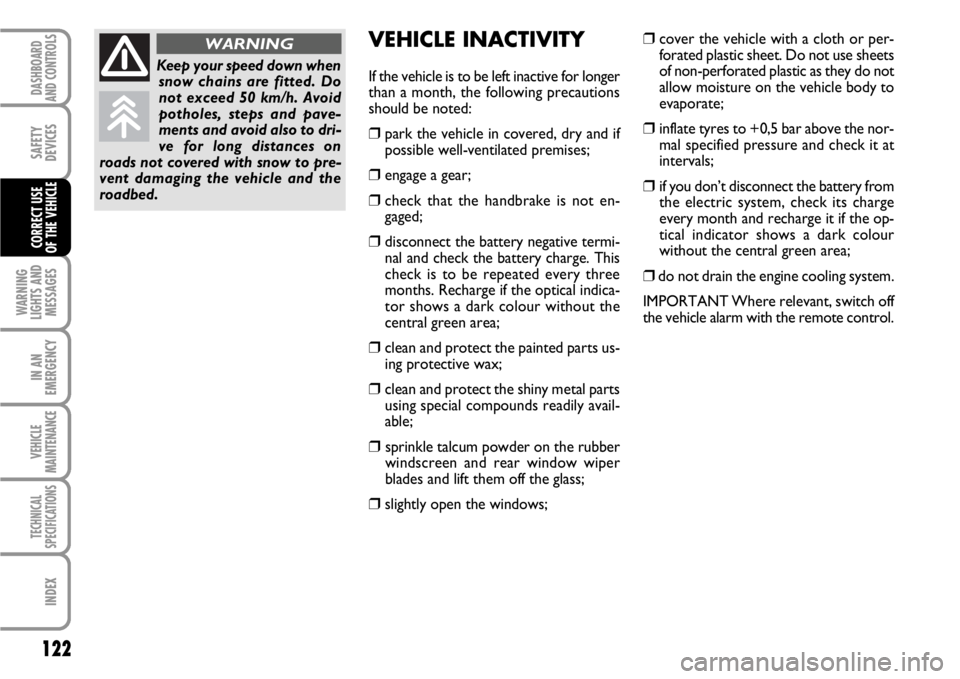
122
WARNING
LIGHTS AND
MESSAGES
IN AN
EMERGENCY
VEHICLE
MAINTENANCE
TECHNICAL
SPECIFICATIONS
INDEX
DASHBOARD
AND CONTROLS
SAFETY
DEVICES
CORRECT USE
OF THE VEHICLE
VEHICLE INACTIVITY
If the vehicle is to be left inactive for longer
than a month, the following precautions
should be noted:
❒park the vehicle in covered, dry and if
possible well-ventilated premises;
❒engage a gear;
❒check that the handbrake is not en-
gaged;
❒disconnect the battery negative termi-
nal and check the battery charge. This
check is to be repeated every three
months. Recharge if the optical indica-
tor shows a dark colour without the
central green area;
❒clean and protect the painted parts us-
ing protective wax;
❒clean and protect the shiny metal parts
using special compounds readily avail-
able;
❒ sprinkle talcum powder on the rubber
windscreen and rear window wiper
blades and lift them off the glass;
❒slightly open the windows;
❒cover the vehicle with a cloth or per-
forated plastic sheet. Do not use sheets
of non-perforated plastic as they do not
allow moisture on the vehicle body to
evaporate;
❒inflate tyres to +0,5 bar above the nor-
mal specified pressure and check it at
intervals;
❒if you don’t disconnect the battery from
the electric system, check its charge
every month and recharge it if the op-
tical indicator shows a dark colour
without the central green area;
❒do not drain the engine cooling system.
IMPORTANT Where relevant, switch off
the vehicle alarm with the remote control.
Keep your speed down when
snow chains are fitted. Do
not exceed 50 km/h. Avoid
potholes, steps and pave-
ments and avoid also to dri-
ve for long distances on
roads not covered with snow to pre-
vent damaging the vehicle and the
roadbed.
WARNING
Page 148 of 210
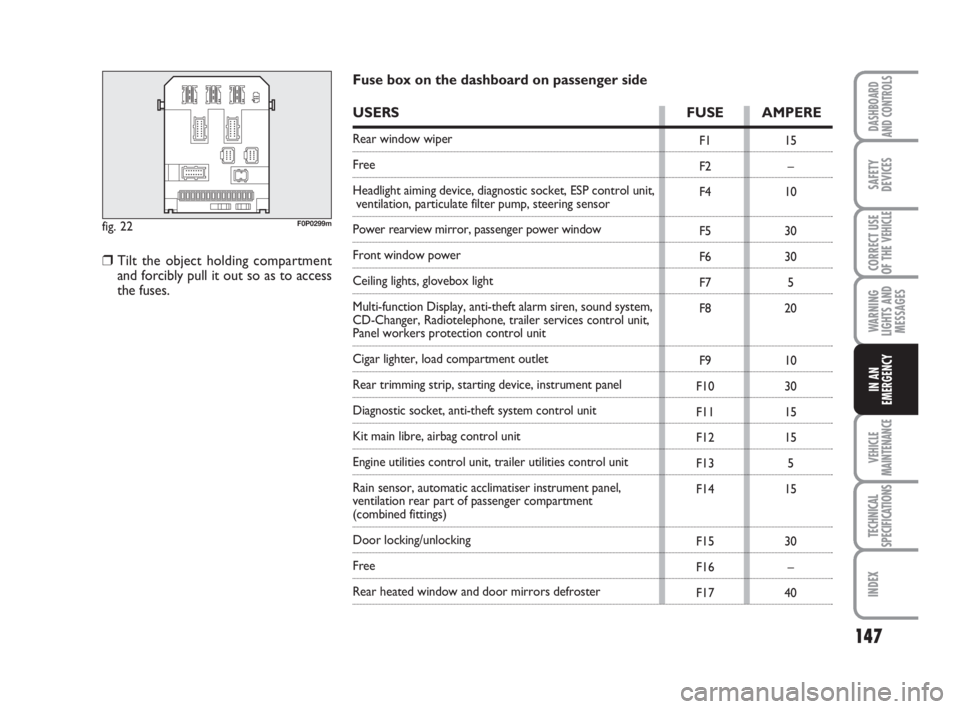
147
WARNING
LIGHTS AND
MESSAGES
VEHICLE
MAINTENANCE
TECHNICAL
SPECIFICATIONS
INDEX
DASHBOARD
AND CONTROLS
SAFETY
DEVICES
CORRECT USE
OF THE
VEHICLE
IN AN
EMERGENCY
fig. 22F0P0299m
F1
F2
F4
F5
F6
F7
F8
F9
F10
F11
F12
F13
F14
F15
F16
F1715
–
10
30
30
5
20
10
30
15
15
5
15
30
–
40
Fuse box on the dashboard on passenger side
USERS FUSE AMPERE
Rear window wiper
Free
Headlight aiming device, diagnostic socket, ESP control unit,
ventilation, particulate filter pump, steering sensor
Power rearview mirror, passenger power window
Front window power
Ceiling lights, glovebox light
Multi-function Display, anti-theft alarm siren, sound system,
CD-Changer, Radiotelephone, trailer services control unit,
Panel workers protection control unit
Cigar lighter, load compartment outlet
Rear trimming strip, starting device, instrument panel
Diagnostic socket, anti-theft system control unit
Kit main libre, airbag control unit
Engine utilities control unit, trailer utilities control unit
Rain sensor, automatic acclimatiser instrument panel,
ventilation rear part of passenger compartment
(combined fittings)
Door locking/unlocking
Free
Rear heated window and door mirrors defroster
❒Tilt the object holding compartment
and forcibly pull it out so as to access
the fuses.
133-152 Nuovo ScudoG9 GB:133-152 Nuovo ScudoG9 GB 16-11-2009 12:01 Pagina 147
Page 149 of 210
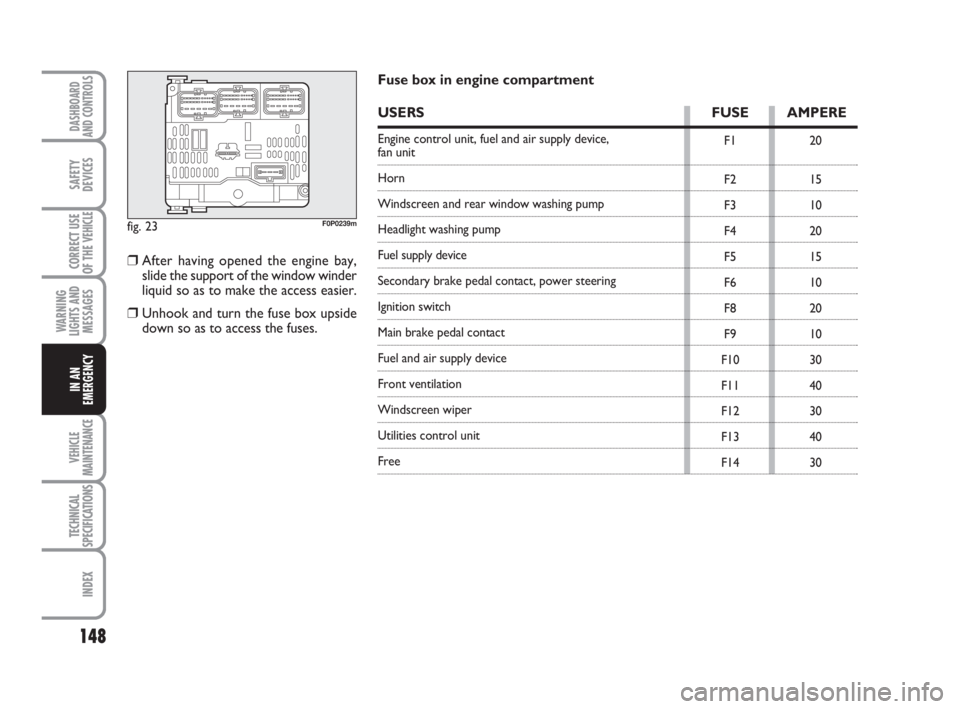
148
WARNING
LIGHTS AND
MESSAGES
VEHICLE
MAINTENANCE
TECHNICAL
SPECIFICATIONS
INDEX
DASHBOARD
AND CONTROLS
SAFETY
DEVICES
CORRECT USE
OF THE
VEHICLE
IN AN
EMERGENCY
fig. 23F0P0239m
F1
F2
F3
F4
F5
F6
F8
F9
F10
F11
F12
F13
F1420
15
10
20
15
10
20
10
30
40
30
40
30
Fuse box in engine compartment
USERS FUSE AMPERE
Engine control unit, fuel and air supply device, fan unit
Horn
Windscreen and rear window washing pump
Headlight washing pump
Fuel supply device
Secondary brake pedal contact, power steering
Ignition switch
Main brake pedal contact
Fuel and air supply device
Front ventilation
Windscreen wiper
Utilities control unit
Free
❒After having opened the engine bay,
slide the support of the window winder
liquid so as to make the access easier.
❒Unhook and turn the fuse box upside
down so as to access the fuses.
133-152 Nuovo ScudoG9 GB:133-152 Nuovo ScudoG9 GB 16-11-2009 12:01 Pagina 148
Page 150 of 210
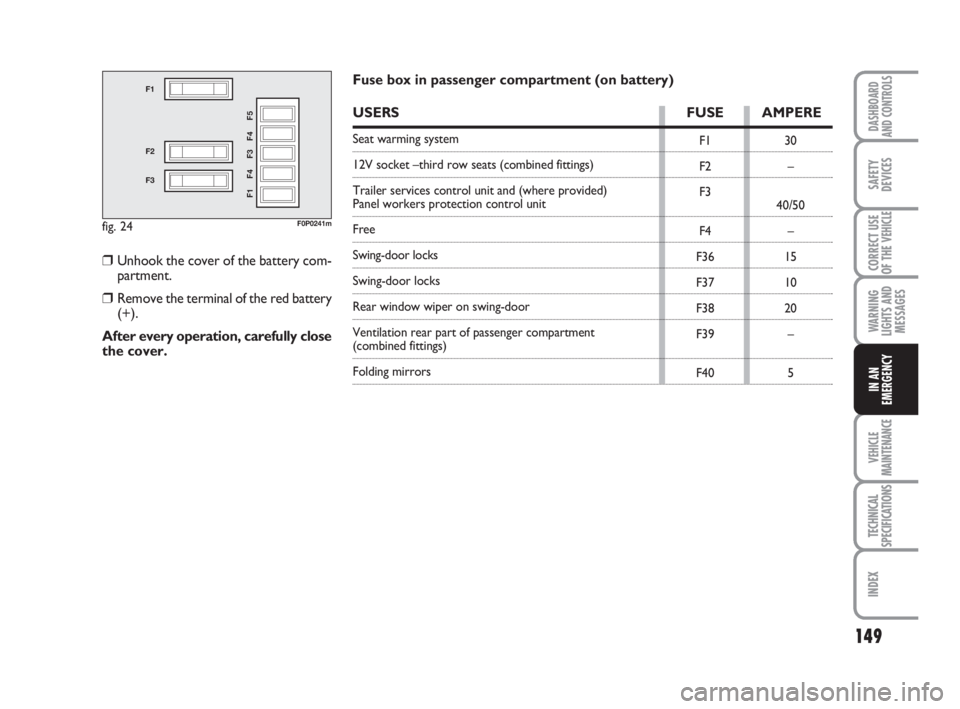
149
WARNING
LIGHTS AND
MESSAGES
VEHICLE
MAINTENANCE
TECHNICAL
SPECIFICATIONS
INDEX
DASHBOARD
AND CONTROLS
SAFETY
DEVICES
CORRECT USE
OF THE
VEHICLE
IN AN
EMERGENCY
fig. 24
F1
F2
F3
F1 F4 F3 F4 F5
F0P0241m
F1
F2
F3
F4
F36
F37
F38
F39
F4030
–
40/50
–
15
10
20
–
5
Fuse box in passenger compartment (on battery)
USERS FUSE AMPERE
Seat warming system
12V socket –third row seats (combined fittings)
Trailer services control unit and (where provided)
Panel workers protection control unit
Free
Swing-door locks
Swing-door locks
Rear window wiper on swing-door
Ventilation rear part of passenger compartment
(combined fittings)
Folding mirrors
❒Unhook the cover of the battery com-
partment.
❒Remove the terminal of the red battery
(+).
After every operation, carefully close
the cover.
133-152 Nuovo ScudoG9 GB:133-152 Nuovo ScudoG9 GB 16-11-2009 12:01 Pagina 149
Page 152 of 210
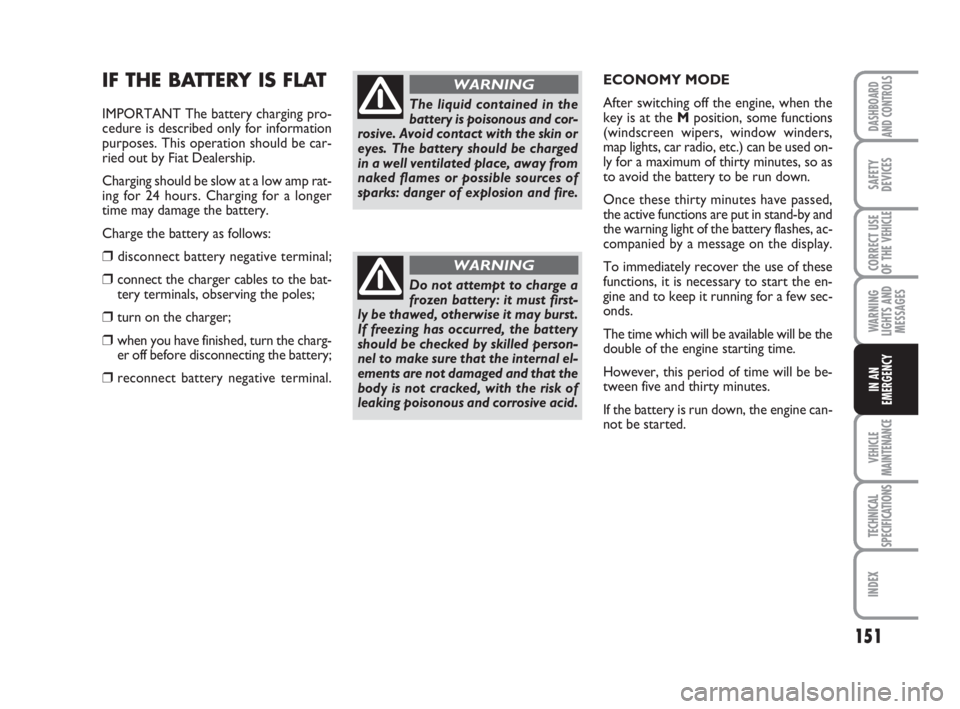
151
WARNING
LIGHTS AND
MESSAGES
VEHICLE
MAINTENANCE
TECHNICAL
SPECIFICATIONS
INDEX
DASHBOARD
AND CONTROLS
SAFETY
DEVICES
CORRECT USE
OF THE
VEHICLE
IN AN
EMERGENCY
IF THE BATTERY IS FLAT
IMPORTANT The battery charging pro-
cedure is described only for information
purposes. This operation should be car-
ried out by Fiat Dealership.
Charging should be slow at a low amp rat-
ing for 24 hours. Charging for a longer
time may damage the battery.
Charge the battery as follows:
❒disconnect battery negative terminal;
❒connect the charger cables to the bat-
tery terminals, observing the poles;
❒turn on the charger;
❒when you have finished, turn the charg-
er off before disconnecting the battery;
❒reconnect battery negative terminal.
The liquid contained in the
battery is poisonous and cor-
rosive. Avoid contact with the skin or
eyes. The battery should be charged
in a well ventilated place, away from
naked flames or possible sources of
sparks: danger of explosion and fire.
WARNING
Do not attempt to charge a
frozen battery: it must first-
ly be thawed, otherwise it may burst.
If freezing has occurred, the battery
should be checked by skilled person-
nel to make sure that the internal el-
ements are not damaged and that the
body is not cracked, with the risk of
leaking poisonous and corrosive acid.
WARNING
ECONOMY MODE
After switching off the engine, when the
key is at the Mposition, some functions
(windscreen wipers, window winders,
map lights, car radio, etc.) can be used on-
ly for a maximum of thirty minutes, so as
to avoid the battery to be run down.
Once these thirty minutes have passed,
the active functions are put in stand-by and
the warning light of the battery flashes, ac-
companied by a message on the display.
To immediately recover the use of these
functions, it is necessary to start the en-
gine and to keep it running for a few sec-
onds.
The time which will be available will be the
double of the engine starting time.
However, this period of time will be be-
tween five and thirty minutes.
If the battery is run down, the engine can-
not be started.
133-152 Nuovo ScudoG9 GB:133-152 Nuovo ScudoG9 GB 16-11-2009 12:01 Pagina 151